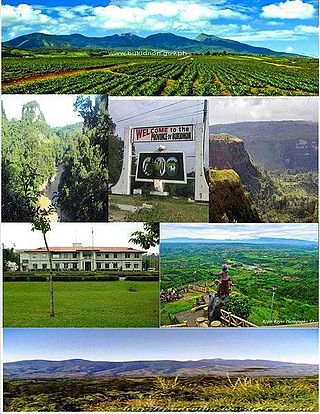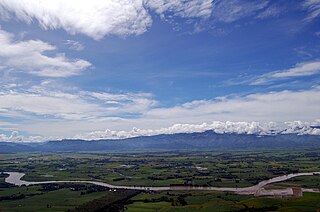
Bukidnon, officially the Province of Bukidnon, is a landlocked province in the Philippines located in the Northern Mindanao region. Its capital is the city of Malaybalay. The province borders, clockwise from the north, Misamis Oriental, Agusan del Sur, Davao del Norte, Cotabato, Lanao del Sur, and Lanao del Norte. According to the 2020 census, the province is inhabited by 1,541,308 residents. The province is composed of 2 component cities and 20 municipalities. It is the third largest province in the country in terms of total area of jurisdiction behind Palawan and Isabela respectively.

Malaybalay, officially the City of Malaybalay, is a 1st class component city and capital of the province of Bukidnon, Philippines. According to the 2020 census, it has a population of 190,712 people.

Lantapan, officially the Municipality of Lantapan, is a 1st class municipality in the province of Bukidnon, Philippines. According to the 2020 census, it has a population of 65,974 people.

Valencia, officially the City of Valencia, is a 2nd class component city in the province of Bukidnon, Philippines. According to the 2020 census, it has a population of 216,546 people.

Impasugong, officially the Municipality of Impasugong, is a 1st class municipality in the province of Bukidnon, Philippines. According to the 2020 census, it has a population of 53,863 people.

San Fernando, officially the Municipality of San Fernando, is a 1st class municipality in the province of Bukidnon, Philippines. According to the 2020 census, it has a population of 63,045 people.

The Pulangi River, also spelled Pulangui, is one of the major tributaries of the Rio Grande de Mindanao, an extensive river system in Mindanao, Philippines. With a length of 320 kilometres (199 mi), it is the longest river in Bukidnon and the 5th longest river in the Philippines. It traverses through majority of the cities and municipalities of Bukidnon from its source in Barangay Kalabugao, Impasugong, Bukidnon.
Bangcud is an urban barangay in the South Highway District of Malaybalay City, Bukidnon, in the Philippines.
Cabangahan is an urbanizing barangay in the South Highway District of Malaybalay City, Bukidnon, Philippines. Located 15 kilometres south of the city proper, it is bounded to the north by Aglayan, to the east by Violeta and Simaya, to the south by Bangcud, and to the west by Bugcaon of the Municipality of Lantapan. According to the 2015 census, Cabangahan has a population of 3,015 people. Cabangahan is generally flat with minor undulations near the bank of the Sawaga River. Agriculture is the most common economic activity, with corn, rice, rubber, and sugarcane being the primary crops. There is only one public elementary school which is administered by the Division of Malaybalay City, Schools District VI.

Can-ayan is a rural barangay in the North Highway District of Malaybalay City, Bukidnon, Philippines. According to the 2015 census, Can-ayan has a population of 5,870 people.
San Jose is an urban barangay in the South Highway District of Malaybalay, Bukidnon. According to the 2015 census, it has a population of 6,856. It is located 6 kilometres south of the city proper and bounded to the north by Casisang, to the east by Can-ayan, to the south by Laguitas and Linabo, and to the west by Magsaysay. San Jose is divided by the Sawaga River into a billowy plain to the west and a hilly and rugged east. It is politically subdivided into fifteen purok. Sitios under its jurisdiction include Santo Niño, Mabuhay, and Panamucan. Santo Niño is located to the west, bordering Barangay Magsaysay. Mabuhay is located along the Sawaga. Panamucan is located to the east on the Paiwaig River. Economy is mainly driven by agriculture, but commerce and industry are growing as a result of the urbanization of Malaybalay. There are many infrastructure, land development and housing projects, including a water reservoir and a diversion road by-passing the city proper and leading into Dalwangan.
Saint Peter is a rural barangay in the Upper Pulangi District of Malaybalay City, Bukidnon. It is situated 63 kilometres northeast of the city proper, on the east bank of the Pulangi River. According to the 2015 census, it has a population of 2,324 people.
Kalasungay is an urban barangay in the North Highway District of Malaybalay, Bukidnon, along the Sawaga River. According to the 2015 census, it has a population of 8,272 people.
Busdi is a rural barangay of the Upper Pulangi District of Malaybalay, Bukidnon, Philippines. According to the 2015 census, it has a population of 2,377 people. It is bounded to the north by Barangay Bulonay of Impasug-ong, to the east by the Municipality of La Paz, Agusan del Sur, to the south by Saint Peter and Kulaman, and to the west by Kibalabag and Manalog.
Caburacanan is a rural barangay of the Upper Pulangi District in Malaybalay City, Bukidnon, Philippines. According to the 2015 census, it has a population of 1,150 people, making it the least populated village in Upper Pulangi. It is bounded to the north by Kulaman, to the east by Saint Peter and Zamboanguita, to the south by Mapulo, and to the west by Can-ayan and Kibalabag. The western part of the village is mountainous with vast old-growth forests and the east is a valley along the Pulangi River, where the village proper is found. The population is mostly Higaunen. It had two sitios under its jurisdiction which are now abandoned: Sambukan, a hamlet to the north; and Talahidan, on the west. Caburacanan has one elementary school administered by the Department of Education, Division of Malaybalay City
Zamboanguita is a rural barangay in the Upper Pulangi District of the city of Malaybalay, Philippines. According to the 2015 census, it has a population of 1,667 people. It is bounded to the north by Saint Peter separated by the Tigpaniki Creek, to the east by the Municipality of La Paz, Agusan del Sur separated by the Pantaron Range, to the south by Indalasa separated by the Pagpag Creek and Mount Mintakdaw, and to the west by Caburacanan and Mapulo separated by the Pulangi River. Zamboanguita sits on a fertile valley between the Pulangi River and the Pantaron Range where most of its area is classified as forestland. It is primarily agricultural with a flourishing commercial activity. It has two sitios: Malilong and Kinuaw. Zamboanguita has one public elementary school, administered by the Department of Education, Division of Malaybalay
Miglamin is a rural barangay in the Basakan District of Malaybalay, Bukidnon, Philippines. According to the 2015 census, it has a population of 3,188 people.
Indalasa is a rural barangay of Malaybalay, Philippines. It is located east of the city in the Upper Pulangi District. According to the 2015 census, it has a population of 1,690 people.

Malaybalay, the capital of Bukidnon, is subdivided into 46 barangays. The Philippine Standard Geographic Code classifies 15 barangays as urban and 31 rural; however, the City of Malaybalay classifies 18 barangays as urban and 28 rural. These barangays are grouped into five administrative districts, namely Basakan, North Highway, Poblacion, South Highway, and Upper Pulangi.
Sinanglanan is a rural barangay in the Basakan District of Malaybalay, Bukidnon, Philippines. According to the 2015 census, it has a population of 3,262 people. It is bordered to the north by San Martin, to the east by Miglamin and Jasaan of the Municipality of Cabanglasan, to the south by Apo Macote, and to the west by Santo Niño.









